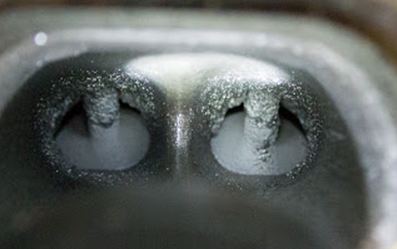We see quite a few Mini Coopers with direct injection engines that have carbon build-up on the intake valves. While direct injection engines do offer enhanced fuel performance and cleaner emissions, these engines are more likely to have an issue with carbon build up on the intake valves.
Here are five Q&A’s related to intake valve carbon build-up.
Q1: How do I know if carbon has built up on the intake valves of my car?
A1: When this happens, you will begin to experience drivability issues like the car not maintaining smooth engine performance, the engine vibrating and shaking after starting the car, or the car jerking or surging at stops. In essence, the engine just isn’t purring along as it should, and in most cases, the check engine light will be on.
Q2: What causes carbon to build-up on the intake valves of Mini Coopers with direct injection engines?
A2: We typically see this problem when a car is running at a less than optimal engine oil level. Some Mini Cooper owners are having their oil serviced every 15,000 miles based on the manufacturer’s recommendation. This is problematic because every 2000 to 3000 miles, the car will consume about a quart of oil. We wrote a blog article on this low engine oil level issue a while back. The oil can become thick and dirty and cause the piston rings in the engine to gum up. This results in an increase in fumes from combustion coming into contact with the intake valves, and this causes carbon build-up. Another issue is that with direct injection engines, the gasoline is no longer being sprayed onto the back of the intake valves. The additives in the gasoline (in non-direct injection engines) actually help to keep the valves clean. The result is that we have this combined effect of cars going too long between oil changes, running low on oil, and the intake valves not benefiting from the cleansing effect of gasoline.
Q3 How do I prevent this intake valve carbon build up from happening?
A3: One of the best ways to prevent this from happening is to change your oil more frequently. Don’t trust the on board computer oil change reminder system. Change the oil and filter every 5000 miles and add BG Products MOA, a protective engine oil additive, at every service. Some people say that using premium gasoline can help with this issue also. Additionally, your auto service shop can check to ensure that the engine management system is functioning correctly.
Q4 What do I do if this happens to my car?
A4: Well, there are a few ways to correct this problem.
- Cleaning the Engine Piston Rings – Your service provider may recommend that the the engine piston rings be cleaned. To do this a special additive is added to the oil and the engine is run at 1200 rpm for 10 minutes. Then the engine oil is drained and a new oil filter is installed along with new oil. If the piston rings are in a very poor shape then the spark plugs have to be removed and a cleaning solution added to each cylinder. This is allowed to soak over night. In very bad cases the engine’s cylinder head has to be removed. The head is then sent to a machine shop for cleaning and repairing of the valve seats.
- Intake Valve Cleaning – If the carbon build up is very bad then your auto service provider may recommend that the valves be cleaned using a spray method which involves injecting a cleaner into the air intake system. In extreme cases the intake manifold is removed and the carbon is blasted off with a special injection system that uses “walnut shells”.
Q5: What’s involved in diagnosing a carbon build up issue like this?
A5: Here is a list of “diagnostics checks” that your auto service shop may perform. A few of them check the integrity of the seals, while others check performance.
- Run a scan and evaluate the codes and data stored in the system or computer
- Conduct a vacuum reading test at idle and at 2000 rpm
- Check the engine blow by
- Check the valve timing
- Check compressions
- Perform a cylinder leak test
The important thing to remember is that regular servicing can help to prevent or catch some of these issues earlier, before you end up with a huge repair bill. Also, if you are having drivability issues, be sure to download our drivability diagnostic questionnaire.







